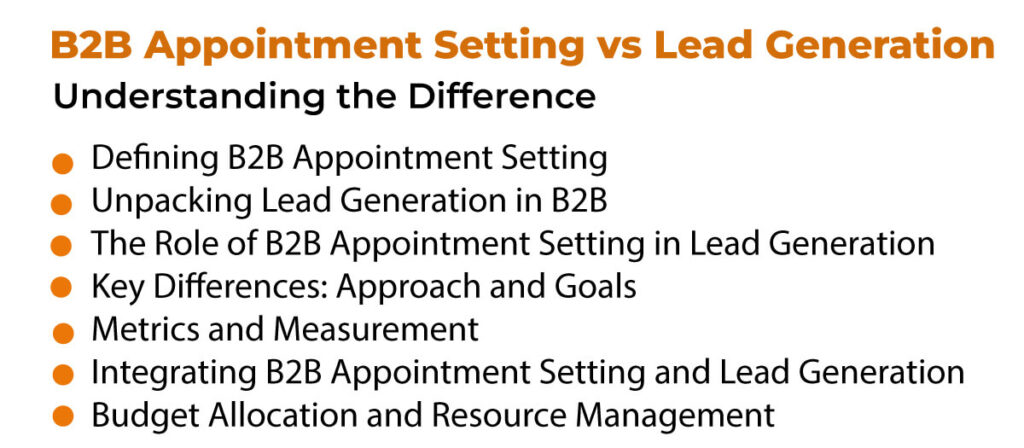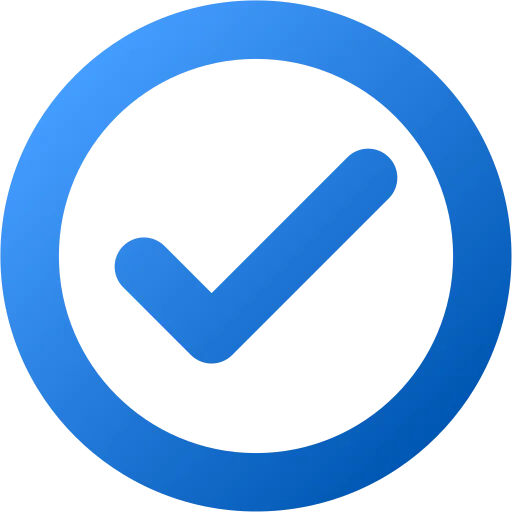
In the ever-evolving landscape of B2B (Business-to-Business) sales and marketing, two critical strategies stand out as linchpins in driving growth and success: B2B Appointment Setting and Lead Generation. These strategies play distinct yet interconnected roles in the complex journey of acquiring and nurturing valuable business relationships.
This blog will delve into the depths of Appointment Setting and B2B Lead Generation, demystifying their definitions, exploring their individual intricacies, and shedding light on how they function in harmony to propel businesses forward. Along the way, we’ll employ relevant data and statistics to paint a vivid picture of their significance and impact.
Must Read: The Art of Qualified Appointment Setting: Strategies to Secure High-Value Meetings
B2B Appointment Setting vs. Lead Generation: Understanding the Difference

Defining B2B Appointment Setting
Let’s begin with B2B Appointment Setting. At its core, B2B Appointment Setting is the process of scheduling appointments, meetings, or interactions between a sales representative and a prospective business client. These appointments are not casual encounters, but rather carefully orchestrated conversations designed to explore mutual opportunities, address specific pain points, and showcase the value a business can offer.
B2B Appointment Setting is akin to the bridge that connects a quality lead with a sales professional. It is the moment when vague interest transforms into a tangible commitment—a meeting or call that can lead to meaningful discussions and, ultimately, to a mutually beneficial partnership.
Must Read: Powerful Tips for B2B Appointment Setting: Strategies and Techniques for Success
Unpacking Lead Generation in B2B
While B2B Appointment Setting focuses on the “when and where” of interactions, Lead Generation casts a wider net. It encompasses the strategies and tactics employed to identify, attract, and capture potential business prospects. In essence, Lead Generation is the engine that fuels the top of the sales funnel, filling it with a stream of potential clients.
Lead Generation is not merely about accumulating contact information; it is about nurturing a pipeline of leads who have expressed interest in a business’s products or services. These leads may come from various sources—website inquiries, content downloads, social media engagement, or even referrals. The goal is to guide them through a nurturing process that gradually transforms them from prospects into well-informed, sales-ready leads.
Must Read: Sales Success Secrets: The Critical Role of Lead Generation and Appointment Setting
The Role of B2B Appointment Setting in Lead Generation
Now that we’ve defined both B2B Appointment Setting and Lead Generation, let’s explore how they interact within the broader framework of B2B sales and marketing.
B2B Appointment Setting is the natural progression of effective Lead Generation. Once leads have been identified, nurtured, and have reached a certain level of interest and qualification, it’s time to initiate direct, personalized interactions. This is where B2B Appointment Setting steps in, setting the stage for meaningful conversations that can lead to conversions.
Imagine a scenario where a potential lead has engaged with your business through various online channels. They’ve downloaded whitepapers, attended webinars, and interacted with your content. While they are undoubtedly interested, they may still have questions, hesitations, or specific needs that require addressing. This is the juncture at which a well-executed B2B Appointment Setting strategy becomes invaluable.
B2B Appointment Setting allows your sales team to proactively reach out to these nurtured leads, offering tailored solutions, addressing concerns, and ultimately guiding them towards making informed decisions. It bridges the gap between passive interest and active engagement, facilitating deeper connections with prospects who are more likely to convert into paying clients.
Must Read: 5 Signs It’s Time to Outsource B2B Appointment Setting
Key Differences: Approach and Goals
To appreciate the distinctions between B2B Appointment Setting and Lead Generation fully, it’s essential to recognize their unique approaches and goals.
Lead Generation is primarily concerned with:
- Generating Interest: Attracting a broad audience and capturing their attention.
- Information Gathering: Collecting data and insights about potential leads.
- Nurturing: Providing value and building trust to move leads through the funnel.
B2B Appointment Setting, on the other hand, shifts the focus towards:
- Qualification: Assessing the readiness and suitability of leads for direct interactions.
- Engagement: Initiating meaningful conversations and fostering relationships.
- Conversion: Moving leads from initial interest to taking concrete actions.
While Lead Generation casts a wide net to identify prospects, B2B Appointment Setting fine-tunes the selection process, identifying those prospects who are not only interested but also prepared to engage further.
Must Read: Generating More Qualified Leads with MQLs: A Pathway to B2B Success
Metrics and Measurement
In the world of B2B sales and marketing, measurement is paramount. It allows businesses to gauge the effectiveness of their strategies, optimize processes, and allocate resources judiciously. Both Lead Generation and B2B Appointment Setting have their own set of metrics that serve as barometers of success.
Lead Generation Metrics often include:
- Conversion Rates: Measuring how many leads progress through the sales funnel.
- Cost per Lead (CPL): Evaluating the efficiency of lead acquisition.
- Lead Quality: Assessing the readiness and potential of leads.
B2B Appointment Setting Metrics encompass:
- Appointment Show Rates: Determining how many scheduled appointments result in actual meetings.
- Conversion Rates: Tracking the percentage of appointments that lead to deals.
- Time-to-Appointment: Measuring the speed at which appointments are scheduled.
These metrics serve as compasses, guiding businesses towards refining their approaches. For instance, if Lead Generation efforts yield a high number of leads but a low conversion rate, adjustments may be needed in the nurturing process. Conversely, if B2B Appointment Setting results in a low show rate for scheduled appointments, strategies to enhance engagement may be required.
Must Read: How to Optimize Your Inbound Lead Qualification Process for 2024
Integrating B2B Appointment Setting and Lead Generation
While B2B Appointment Setting and Lead Generation are distinct strategies, they are not mutually exclusive. In fact, they are most potent when integrated seamlessly. Here’s how this integration can benefit businesses:
Enhanced Lead Quality:
Integrating B2B Appointment Setting with Lead Generation ensures that leads entering the appointment setting phase are well-qualified and genuinely interested.
Efficient Resource Allocation:
By focusing B2B Appointment Setting efforts on leads with higher conversion potential, resources are allocated where they are most likely to yield results.
Shorter Sales Cycles:
Combining these strategies streamlines the buyer’s journey, reducing the time it takes for leads to move from initial interest to conversion.
Closed-Loop Feedback:
Insights from B2B Appointment Setting interactions can be fed back into Lead Generation efforts, informing content creation and nurturing strategies.
Must Read: Lead Scoring Strategies That Boost Conversion Rates: The Road to Sales Success
Budget Allocation and Resource Management
An often-debated question in B2B sales and marketing is where to allocate budget and resources: towards Lead Generation or B2B Appointment Setting? The answer lies in understanding your business’s unique needs and objectives.
Businesses with longer, more complex sales cycles may find it beneficial to allocate more resources to Lead Generation. A robust Lead Generation strategy ensures a constant influx of potential leads, feeding the top of the funnel.
Conversely, organizations with shorter sales cycles or specialized offerings may prioritize B2B Appointment Setting. This allows them to capitalize on the efficiency of direct interactions, quickly moving leads through the funnel.
Must Read: Revolutionizing Lead Generation with Automated Lead Qualification: A Data-Driven Guide
Conclusion
In B2B sales and marketing, Lead Generation and B2B Appointment Setting are not rivals but allies, working together harmoniously. To succeed, understand your business’s needs, tailor your strategy, and integrate these approaches effectively.
In a landscape valuing relationships and data-driven choices, this synergy is the key to unlocking your business’s potential. Embrace this dynamic duo, blending their strengths to elevate your B2B endeavors. Adaptability in merging these methods is your route to enduring growth and success. Thrive in the intricate world of B2B engagement.

Vikas Bhatt is the Co-Founder of ONLY B2B, a premium B2B lead generation company that specializes in helping businesses achieve their growth objectives through targeted marketing & sales campaigns. With 10+ years of experience in the industry, Vikas has a deep understanding of the challenges faced by businesses today and has developed a unique approach to lead generation that has helped clients across a range of industries around the globe. As a thought leader in the B2B marketing community, ONLY B2B specializes in demand generation, content syndication, database services and more.


